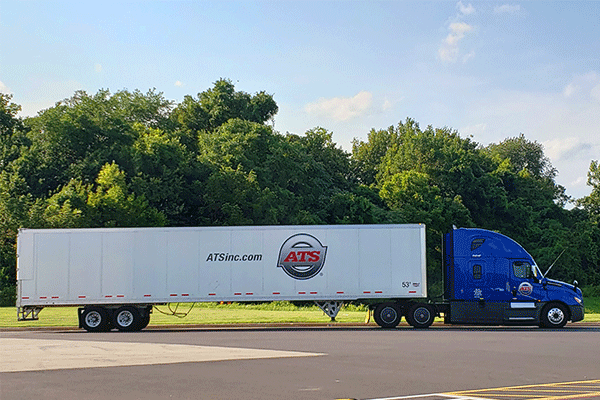Shipping large quantities of freight to a wide array of receivers can be a complex task. But understanding the best way to do this, what options are on the table and which services fit your supply chain is important.
Often, it can feel as though this information simply isn’t for you to know and this can be frustrating. That said, you’ve recently heard of a shipping method called “zone-skipping” and are looking for more information on how this can help your business progress.
ATS has been helping shippers and receivers, like you, navigate the shipping industry for over 65 years. During this time, we’ve supplied and overseen zone-skipping operations for many companies so we know what it takes to facilitate it successfully.
Below, we’ll outline:
- What zone-skipping is in freight shipping
- Who zone-skipping is best for
- How zone-skipping impacts freight shipping price.
At its conclusion, this blog will leave you with a far better grasp on whether zone-skipping can benefit your business and how you can make sure that you’re doing it as efficiently as possible.
What is Zone-Skipping?
Zone-skipping is a unique freight delivery service where the shipper of a product sends a large amount of inventory/product to a central facility. This facility — which is located within the regional vicinity of the end-point receivers — acts as a single touchpoint for the freight following its line-haul.
At this destination terminal facility, the product is parceled up and sent out in small increments to the shipper’s customers/receivers located in the area. This helps the freight transportation process in several ways as some of the common hangups — like unreliable transit timing — of other shipping methods can be avoided.
An easy way to visualize this process is to think of zone-skipping like the anatomy of a bicycle tire. In this analogy, the “hub” — located at the center of a tire — is the main distribution center for the overarching shipment. Each of the “spokes” — branching from the hub’s axel — are the various trucks charged with distributing the product.
Although making the connection between the spokes of a bike wheel and the various off-shoots of zone-skipping may feel like a stretch, it does an apt job laying this process out visually.
Note, the complexity of this process and the logistical oversight necessary to facilitate its success, depends on the amount of freight in transit and the number of receivers on the back end.
Who is Zone-Skipping a Good Fit For?
Zone-skipping is great for any shipper who needs to get a large amount of freight rolled out to a wide range of customers located throughout a particular region.
Often, zone-skipping benefits corporations who would normally send a large amount of freight to separate locations using multiple LTL carriers.
Instead of sending product via numerous less-than-truckload (LTL) carriers — a process that can increase transit timing — zone-skipping makes the long-haul section (the longest leg of a shipment’s journey) more predictable. This, in turn, increases on-time delivery rates for these shippers.
As such, if you’re a shipper who can consolidate your inventories onto a single truck for the long-haul portion of your shipment and have many drop-off points in a particular region, zone-skipping is worth consideration.
Who is Zone-Skipping Not a Good Fit For?
If you’re a shipper who has customers strewn around the country without an easily discernible central location, zone-skipping will not fit your business.
At the end of the day this freight shipping method rests it’s employability on the ability to dispatch multiple less-than-truckload carriers from a location in the vicinity of the end recipient.
As such, if your supply chain doesn’t focus on a single or a few central regions zone-skipping isn’t for you.
How Does Zone-Skipping Impact Price?
The price of zone-skipping — like many aspects of freight shipping — is subject to the fluctuations between supply and demand and their relation to the amount of capacity you need. That said, there are two general ways that zone skipping can impact the price you pay for your shipments.
1 . Fewer Touchpoints = Lower Claim-Rates
The first advantage of zone-skipping is directly tied to touchpoint visibility.
When moving freight, maintaining visibility over the “touchpoints” or: the points in your freight’s journey where it is handled, moved and adjusted before its arrival — although important — can become difficult.
Zone-skipping is a great way for shippers and receivers to avoid the frequent handling of products at these “touchpoints”.
Since liability issues can arise from these activities due to damaged or lost freight, the fewer touchpoints your product endures, the less chance it has to get damaged or lost. In turn, this saves shippers the money they’d pay through damaged and lost freight claims as a result of product handling.
2. Lower Shipping Cost When Capacity is Tight
In addition to reduced claim rates, zone-skipping has become increasingly popular in recent years as capacity restraints due to a shortage of truck drivers coupled with rising demand drive the price of trucking solutions up.
Instead of moving a smaller amount of shipments using multiple trucks, zone-skipping allows shippers to combine these lighter shipments onto a single larger truck. When the supply of available trucks, drivers and trailers is lower than the demand for their services, booking a single truck is less expensive than sourcing and paying for multiple.
As such, consolidating inventories onto a single truck for the majority of its journey has become more cost-effective than employing multiple trucks to move the same amount of freight.

Ask Your Freight Shipping Partner About Zone-Skipping
Now that you understand how zone-skipping — when done correctly — can cut down transit timing, increase on-time delivery rates and pad your bottom line, you’re ready to put it to work for your business.
To do this, you’ll want to find a transportation provider with a demonstrated history of successfully utilizing this service. Ask your potential partner about the advantages of zone-skipping, how they’d put it to use for you and what you can do to make the zone skipping process as smooth as possible.
The right partner will clearly and accurately assess your needs and answer these questions in a way that leaves you confident in their abilities.
If you’d like to learn more about three other methods for shipping freight, check out this blog where we discuss why transit time varies so much between LTL, PTL and FTL shipments.
Finally, if you’ve got questions about how ATS can help you with your next shipment, please reach out. We’re always happy to help.





